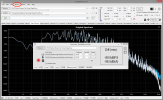I guess I'm missing a sense of what would be considered a "big" or "small" difference in all these plots... Again, they sound exactly the same to me, after some level matching. Loaded the files in a random generator and ran a paired preference test on the first 30 seconds or so. I got 7-3 preference for the re-mastered version, which is not really statistically significant, don't have the time now to significantly increase the samples number.
Not sure if this was previously answered, how is the PK metric calculated?
Note: both files don't play properly in WASAPI exclusive mode; sound is jagged, like, play stops every 200mS or so, for long enough to make impossible to listen to. Works fine without exclusive mode. Win 10 latest patched version.
Settings:
Gain:True, Remove DC:True
Non-linear Gain EQ:False Non-linear Phase EQ: False
EQ FFT Size:65536, EQ Frequency Cut: 0Hz - 0Hz, EQ Threshold: -500dB
Correct Non-linearity: False
Correct Drift:True, Precision:30, Subsample Align:True
Non-Linear drift Correction:False
Upsample:False, Window:Kaiser
Spectrum Window:Kaiser, Spectrum Size:32768
Spectrogram Window:Hann, Spectrogram Size:4096, Spectrogram Steps:2048
Filter Type:FIR, window:Kaiser, taps:262144, minimum phase=False
Dither:False bits=0
Trim Silence:False
Enable Simple Waveform Measurement: False
Discarding Reference: Start=0s, End=0s
Discarding Comparison: Start=0s, End=0s
Initial peak values Reference: -6.563dB Comparison: -0.266dB
Initial RMS values Reference: -23.558dB Comparison: -15.638dB
Null Depth=5.459dB
Phase inverted
X-Correlation offset: -16789 samples
Residual error too large 3.728246898. Trying alternative drift correction method
Drift computation quality #2: Excellent (1.26μs)
Trimmed 0 samples ( 0.00ms) front, 0 samples ( 0.00ms end)
Final peak values Reference: -6.563dB Comparison: -8.889dB
Final RMS values Reference: -23.558dB Comparison: -24.32dB
Gain= 8.7444dB (2.7367x) DC=0 Phase offset=-380.702948ms (-16789 samples)
Difference (rms) = -20.92dB [-24.92dBA]
Correlated Null Depth=14.4dB [20.67dBA]
Clock drift: -0.34 ppm
Files are NOT a bit-perfect match (match=0.02%) at 16 bits
Files match @ 49.9921% when reduced to 3.66 bits
---- Phase difference (full bandwidth): 90.2281195832894°
0-10kHz: 105.78°
0-20kHz: 92.01°
0-24kHz: 90.23°
Timing error (rms jitter): 20.4ms
PK Metric (step=400ms, overlap=50%):
RMS=-21.6dBFS
Median=-22.9
Max=-13.8
99%: -15.47
75%: -19.4
50%: -22.94
25%: -32.04
1%: -57.59
gn=0.365409454656468, dc=0, dr=-3.38575459151237E-07, of=-16789.0000002714
DONE!
Signature: a911b4af92b90891658be9eb050a0679
RMS of the difference of spectra: -86.1671776658777dB
DF Metric (step=400ms, overlap=0%):
Median=0dB
Max=2.3dB Min=-8.4dB
1% > -4.09dB
10% > -0.82dB
25% > -0.36dB
50% > 0.02dB
75% > 0.33dB
90% > 0.78dB
99% > 1.57dB
Linearity 2.6bits @ 0.5dB error
View attachment 210868
View attachment 210870
View attachment 210872
